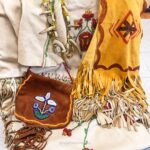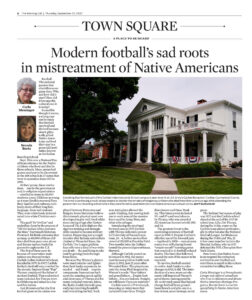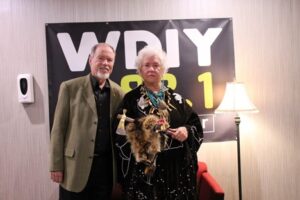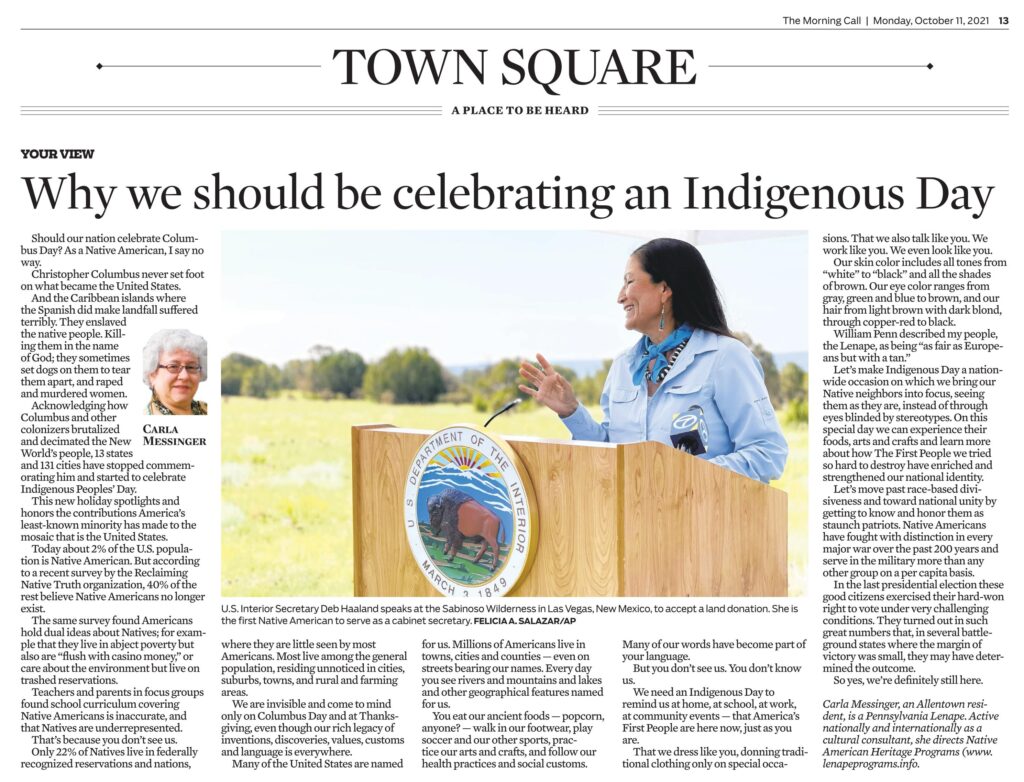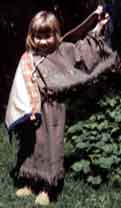
We have video presentation/demonstration programs from the Tracing Footsteps curriculum project by Dance Education Laboratory (DEL) on Native American dance for use in NYC public schools on Native American Heritage Programs – YouTube
I participated in a video conference workshop through Lee and Low Book Publishers, this includes the different resources that were discussed during the webinar: https://blog.leeandlow.com/2020/11/18/watch-the-webinar-a-discussion-of-contemporary-native-childrens-literature/. A TV interview on Channel 69 is also on Native American Heritage Programs – YouTube.
In addition, I have included my book, When the Shadbush Blooms on the page. You can purchase a dedicated and signed copy from our Book for Sale page in the Shadbush section. You may purchase the book in bulk through Lee and Low Publisher Native American, Indigenous Children’s Books | Lee & Low Books (leeandlow.com)
Attention: New York Teachers & Parents, a great resource is the Spring 2021 Edition of the National Museum of the American Indian titled Exploring Native New York!
Lenape Lifeways program at Ridgefield Park (6/2024) HERE
Special Thanks to Michelle DeLuca from Ridgefield Park
Listen to 2023 Roll of Native Women past and present HERE
EDITORS NOTE: CORRECTION Womans right to vote was 1920 (1928 was UK) Native American Heritage Programs – YouTube Click the link for a variety of short videos for children & adults.
Native American Heritage Programs – YouTube Click the link for a variety of short videos for children & adults.
Newspaper articles are below this article.
LEHIGH COUNTY AGING AND A DULT SERVICES UNSUNG HERO AWARDS 2022 – Carla J.S. Messinger
DULT SERVICES UNSUNG HERO AWARDS 2022 – Carla J.S. Messinger
Carla Messinger’s long history of volunteerism and service in Lehigh County deserves to be recognized and celebrated. For 25 years she was the full-time unpaid Acting Executive Director and primary docent of Allentown’s small Lenape museum. There she presented programs and organized events on-and offsite for thousands of school children and the general public, including people of every age and ability level–all without receiving a paycheck, benefits, or health coverage.
Carla went on to found Native American Heritage Programs in 2002 and as its director presents programs at schools and colleges, social groups, businesses, government agencies, and festivals, often accepting such modest compensation that she is a de facto volunteer!! Moreover, for over 35 years she has regularly bought, gathered, and distributed clothing and personal care items to William Allen High School students, working with Donna Balascak until that teacher retired, then with others until the pandemic arrived. Carla also makes monthly contributions to food banks and donates supplies to Cedarbrook at Fountain Hill.
Her ongoing outreach and achievements in the local and regional community deserve all the positive adjectives named in this application. She is inspiring because she so completely embodies the spirit of volunteerism while tirelessly pursuing her life’s mission–sharing the contributions Native Americans have made to the culture now shared by those living where her Pennsylvania Lenape ancestors did at the time of Columbus.
Carla is also courageous, because she tirelessly advocates for a minority’s rights at a time when equality and inclusiveness are very controversial issues. Her work is unusual and to some extent innovative, because 40 percent of Americans believe Native Americans no longer exist, and no one else in this area is as committed as Carla to making them visible and describing their legacy.
Extraordinarily generous and kindhearted, she is a very supportive person who is always ready to respond helpfully to teachers and students consulting her information-packed 100+ page Native American Heritage Programs website, lenapeprograms.info. She’s a wonderful friend as well–volunteering often to do necessary shopping or driving, share information or home-cooked food, provide companionship when it’s needed, or perform other errands or favors. Deeply compassionate, she readily goes out of her way to help anyone in trouble. And while doing any of the above, she is unfailingly cheerful!
Carla’s pro-bono efforts as an educational consultant reach and impact many people in the community. She has donated copies of her prizewinning children’s book When the Shadbush Blooms to libraries and several schools in the Lehigh Valley, writes Opinion pieces for The Philadelphia Inquirer and the Morning Call, and recently did a half-hour appearance with John Pearce on Bethlehem’s WDIY NPR station (88.1 FM) and a 15-minute segment on the Sunrise Show on WFMZ Channel 69 TV.
There are several newspaper articles on this page and additional links below them.
Recognizing Native American Contributions and History with Carla Messinger | Perspectives (wdiy.org)
Recognizing Native American Contributions and History with Carla Messinger | Perspectives
John Pearce welcomes Carla Messinger, a Lenape descendant and Director, Cultural Educator, Consultant and Preservationist at Native American Heritage Programs, for a conversation about the many facets of Native American life – then and now.
They talk about the origins and many contributions of Native Americans to our society, and also why Native Americans are “invisible,” despite the fact that they live, work and play amongst us.
Tune in to Perspectives to hear about local history and the humanities, residents’ stories, and organizations doing good in their neighborhoods. New episodes air the fourth Thursday of every month from 6:00 to 6:30 PM following All Things Considered.
Published November 25, 2022 at 11:00 AM EST
Lenape History and Heritage with Carla Messinger | Perspectives

John Pearce brings focus to the Lenape Indigenous people from the Lehigh Valley region with guest Carla Messinger, a cultural educator, Lenape heritage conservationist, and nationally recognized author, as she takes listeners back through local history and the importance of teaching indigenous heritage programs to the next generations.
Tune in to Perspectives to hear about local history and the humanities, residents’ stories, and organizations doing good in their neighborhoods. New episodes air the fourth Thursday of every month from 6:00 to 6:30 PM following All Things Considered.
Lenape History and Heritage with Carla Messinger | Perspectives (wdiy.org)
 (In most states, social studies and history curricula provide little or no coverage of the important role Indigenous people have played in our national history and culture. California became the first state to make ethnic studies a required class for high school graduation to help students understand the past and present struggles and contributions of Black, Asian, Latino, and Native/Indigenous Americans in the United States. Read more – Myung J. Chun / Los Angeles Times)
(In most states, social studies and history curricula provide little or no coverage of the important role Indigenous people have played in our national history and culture. California became the first state to make ethnic studies a required class for high school graduation to help students understand the past and present struggles and contributions of Black, Asian, Latino, and Native/Indigenous Americans in the United States. Read more – Myung J. Chun / Los Angeles Times) Friday, November 26, 2021 Today’s Paper Opinion
Racist U.S. history curriculums omit important stories of America’s First People | Opinion
by Carla Messinger, For The Inquirer Published Nov 24, 2021
At the time of Columbus, anywhere from seven million to 15 million Indigenous people were living in the continental U.S. Over the following centuries, one million to four million or more were exterminated through war or diseases or forcibly assimilated into the dominant white culture. Along the way, the U.S. violated more than 500 treaties and stole 1.5 billion acres of Indigenous land.
Yet in most states, social studies and history curricula provide little or no coverage of the important role America’s First People have played in our national history and culture.
The erasure of the First People and their cultures has been so successful that a Reclaiming Native Truth survey found 40% of Americans believe we no longer exist.
But we do! The 2020 Census documented 9.7 million American Indians and Alaska Natives. Around 24% live mostly out of sight in 574 federally recognized nations or reservations or in 68 state-recognized tribes. Even more invisible are the 76% residing unnoticed in urban, suburban, and rural areas. All suffer from the systemic social and environmental injustice continuing to roil our nation.
To get past the divisiveness and equity issues threatening our unity, we must realize that America is strong not despite its diversity but because of it. We can reach that moment by making our Native neighbors, their cultures, and their contributions visible. Unfortunately, we can’t do that until the heavily redacted American history taught in our schools gives way to a more complete and accurate account that tells the story of our nation’s original people.
This is slowly starting to happen.
Surveying 35 states with federally recognized tribes in 2019, the National Congress of American Indians found nearly 90% reported working to improve the quality of and access to a Native American curriculum in their schools. However, less than half said it was required and specific to tribal nations in their state.
So far, media coverage of Native-oriented education in public schools has focused mostly on states with the largest Indigenous population. (In 2020 the top six were Arizona, California, Oklahoma, New Mexico, Texas, and Minnesota.) Attention has also been given to education provided by federally recognized tribes and huge reservations like Pine Ridge.
Although this emphasis seems understandable, 644,000 Indigenous K-12 students live throughout the U.S. What’s more, 90% of them are enrolled in public school systems.
As acclaimed Native historian and educational activist Roxanne Dunbar-Ortiz has pointed out, the dehumanizing myths and misconceptions that hurt Native American students flourish at the beginning of the school year. At this “loaded” time, all America celebrates the Indian-killing Christopher Columbus and attends sports events where over 900 Indian-named teams such as the World Series-winning Atlanta Braves attract war-whooping, “tomahawk-chopping” crowds. Then comes the iconic Thanksgiving holiday commemorating “the arrival of the religious Europeans who set the stage for Native American genocide.”
Dunbar-Ortiz urges educators to use November, which is Native American Heritage Month, to “discuss the reality of life, historical and current,” for the Native American students in our public schools.
» READ MORE: ‘We’re still here’: Native Nations Dance Theater continues its legacy during Native American Heritage Month
Indigenous children have a long history of being miseducated. From 1869 to the early 1980s, thousands were taken from their families and sent to an estimated 350 Indian boarding schools run by federal administrators and religious organizations. At their peak, these infamous schools were home to 60,000 children annually.
There they endured brutal mistreatment intended to “kill the Indian and save the man.” Many died from malnourishment, abuse, and disease and were buried in unmarked mass graves only now being unearthed.
When the U.S. passed laws to remove and relocate Indians so others could access their resource-rich lands, those who moved were promised benefits including education “in perpetuity.” That promise has been poorly kept.
In the 183 schools on 64 reservations in 23 states run by the Bureau of Indian Education, graduation numbers and test scores are the lowest in the nation.
The 90% of Indian students in public schools do not fare well, either. Lacking self-esteem and trust in the educational system, up to 36% of Native American students drop out of school, mostly between grades seven and 12. The rate is highest among those in cities, towns, and suburbs, where their culture is little known, and they are disciplined and suspended more than other students.
And the harm doesn’t stop there. The racism embedded in lessons that unfairly portray or even omit Native Americans fuels prejudice and discrimination among their classmates and in our society.
States such as Montana, Oregon, Connecticut, and North Dakota have tackled this issue by passing laws mandating that all students study social studies and history lessons that include Native America. As momentum builds, additional states are reviewing educational policies and standards, adding requirements, or expanding curricula.
For that, let’s all give thanks this November.
Carla Messinger is a Pennsylvania Lenape. A cultural consultant and preservationist, she directs Native American Heritage Programs. www.lenapeprograms.info
Published Nov. 24, 2021 CM Carla Messinger, For The Inquirer

The Inquirer Thursday, November 26, 2020 Opinion
 The Inquirer welcomes essays, op-eds or commentaries on newsworthy issues and trends from people outside the newsroom.
The Inquirer welcomes essays, op-eds or commentaries on newsworthy issues and trends from people outside the newsroom.
Skip ‘Black Friday’ and celebrate Native American Heritage Day | Opinion
Mark Soldier Wolf, left, and his daughter, Yufna Soldier Wolf, center, look over a historical photo on Aug. 9, 2017 as they tour the Carlisle Barracks, which once served as the Carlisle Indian Industrial School in Pennsylvania.
Although 325 Native reservations are sited mostly in remote areas nationwide, 72% of indigenous Americans in the U.S live mostly unnoticed in urban and suburban areas.
Many non-Indigenous Americans have the misperception that Native Americans are only part of the United States’ past, not its present.
Most Americans think of the day after Thanksgiving as Black Friday, but it’s another national holiday — Native American Heritage Day.
That Friday on the calendar could be “Blank” instead of “Black,” because many Americans—40%, according to one survey—don’t believe Native Americans still exist!
But we do. Over 5 million of us live in 37 states. Like the rest of the country, we’re a diverse people living in cultures shaped by hugely different environments and experiences. Knowing that should help explode all the myths, misinformation, and stereotypes about us that abound in history books, popular culture, and non-indigenous minds. No, we don’t all wear blankets and feathers. No, we don’t all live in tepees and hunt buffalo. And no, we aren’t the whooping, red-painted, tomahawk-waving savages portrayed by sports fans at games of the over 1,000 schools that still have belittling, cartoonish “Indian” mascots.
» READ MORE: In Pennsylvania public schools, an ‘epidemic’ of Native American mascots and nicknames
But yes, we are still here. What’s more, our rich legacy of inventions, discoveries, values, customs, and language is everywhere. Twenty-six of the United States are named for us. Millions of Americans live in towns, cities, and counties — even on streets — bearing our names. Every day they see rivers and mountains and lakes and other geographical features named for us. They eat our ancient foods (popcorn, anyone?), walk in our footwear, play lacrosse and our other sports, practice our arts and crafts, and follow our health practices and social customs.
Today, 574 federally recognized Native Nations are spread over the vast landmass that is our country. Although 325 reservations are sited mostly in remote areas, 72% of indigenous Americans in the U.S live mostly unnoticed in urban and suburban areas.
We live, work, and dress like you. We also look like you. Our skin, eye, and hair color comes in all tones. In William Penn’s account of the Lenni Lenape or Delaware Indians, he described my people, the Lenape, or Delaware, as being as fair as Europeans but with a tan.
Indigenous people become more visible in November, which is Native American Heritage month, and especially around Thanksgiving, arguably our nation’s most iconic holiday. We imagine neighborly Wampanoag Indians sitting around a big table with Pilgrims, sharing the turkey, pumpkin, corn, and cranberries they brought to the feast. But let’s take another look at that pretty picture.
It’s true that the Wampanoag and other Indians shared the protein-rich, highly nutritious foods they had cultivated over centuries with the early colonists. They also shared much else. In fact, historians say that if early European settlers encountered what they expected — an uncultivated wilderness roamed by nonhuman savages — they could not have survived.
» READ MORE: Telling a Native story from Native perspectives: Revisiting Pennsylvania’s Conestoga massacre | Opinion
In her award-winning book, An Indigenous Peoples’ History of the United States, Roxanne Dunbar-Ortiz writes that long before Europeans came, vast numbers of indigenous people “had developed towns, farms, and networks of roads, with villages that were part of nations and federations of nations that had varied, highly sophisticated systems of government and diplomacy.” Some trails frequented for trade — like those used by my people, the Lenape — still exist today.
Dunbar-Ortiz and others have documented that almost everything not willingly given by our Native neighbors was taken from them. Settlers stole “already cultivated farmland and the corn, vegetables, tobacco and other crops domesticated over centuries….used existing roads and water routes in order to move armies… and relied on captured indigenous people to identify the locations of oyster beds, and medicinal herbs.”
As for the first Thanksgiving, what we think we know just isn’t so. There’s no evidence to suggest the first official Thanksgiving Day was a festive gathering to which Pilgrims generously invited Indians.
» READ MORE: Kamala Harris follows Kaw Nation’s Charles Curtis as the second person of color to become vice president
And it wasn’t the food Indians brought to that mythical feast that was their first, indispensable contribution to America. The gift they gave was the entire way of life they had created over many hundreds of years. A gift that’s reason enough to declare and celebrate Native American Heritage Day every November.
Although we have contributed so much to the mosaic that is America, Natives are still living under the weight of colonization, still striving to preserve our diverse cultures, and still struggling to secure the voting rights and equality we’re owed as citizens. We are patriotic Americans. In fact, thousands of Native men and women serve in the U.S. military—more than any other minority on a per capita basis.
Just like anyone else, we want a better world. So please look at us through eyes unblinded by stereotypes, accept us as we are, and join with us to help make a better future for all our children.
Carla Messinger is a Lenape who works nationally and internationally as a cultural educator and directs Native American Heritage Programs in Pennsylvania (lenapeprograms.info).
- CM Carla Messinger, For the Inquirer Published Nov 26, 2020 Skip ‘Black Friday’ and celebrate Native American Heritage Day | Opinion (inquirer.com)
~~~~~~~~~~~~~~~~~~~~~~~~~~~~~~~~~~~~~~~~~~~~~~~~~~~~~~~~~~~~~~~~~~~~~~~~~~~~
What they did not print:
As for the first Thanksgiving, what we think we know just isn’t so. The first official Thanksgiving Day wasn’t a festive gathering of Indians and Pilgrims. According to anthropologist William B. Newell, it celebrated the massacre of 700 Pequot men, women, and children.
Newell is a Penobscot scholar who formerly chaired the anthropology department at the University of Connecticut. His deep dive into a large trove of historic documents revealed that “Thanksgiving Day was first officially proclaimed by the Governor of the Massachusetts Bay Colony in 1637 to commemorate the massacre of 700 men, women and children who were celebrating their annual green corn dance–Thanksgiving Day to them–in their own {religious} house.” Gathered there, “they were attacked by mercenaries and Dutch and English, who ordered the Indians from the building and shot them down as they emerged. The rest were burned alive in the building.”
According to Newell, our image of the first Thanksgiving Day is fictitious, and the century of Thanksgivings that followed also commemorated the killing of Indians. That grim reality foreshadowed a future in which the European newcomers slaughtered 1 to 4 million indigenous men, women, and children, stole 1.5 billion acres of their land, and violated 500 treaties.
Other links for you:

